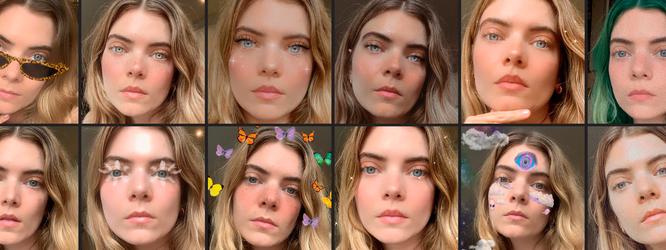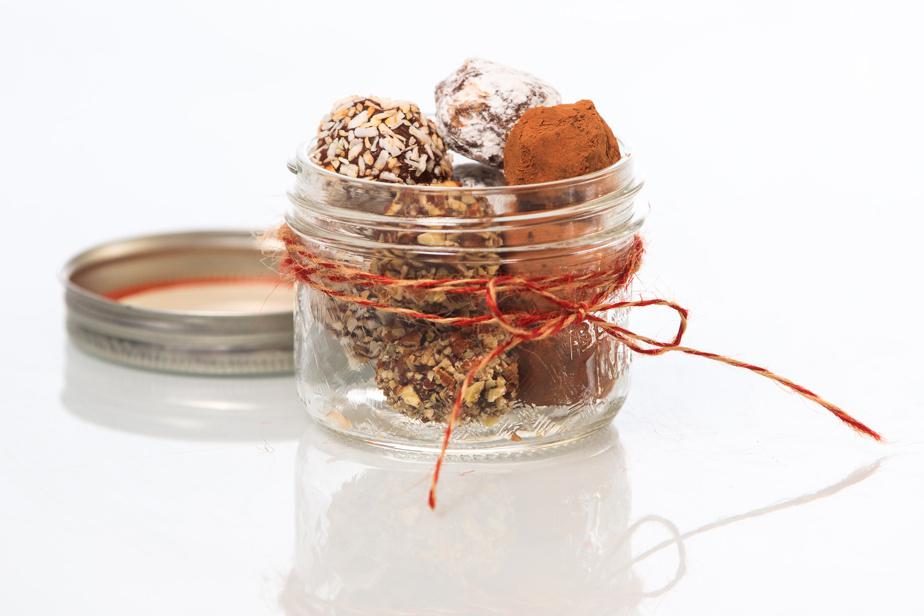Instagram, Snapchat: how not to be obsessed with beauty filters?
They are inspired by conventional models of beauty and set trends that can damage self-esteem. Why do beauty filters take such an important place in our lives? Decryption of a practice pushed to such an extreme that some prefer to boycott it.
ByMargaux RavardHave filters always had the ambition of perfecting our appearance? I remember “lenses”, the first filters that appeared on Snapchat in January 2015. The famous crown of flowers, used on all selfies at the time, already softened the skin and masked dark circles. Convenient. But above all, the distorting filters were intended to make people laugh: dog, deer, geek or flag of Paraguay, you could become almost anything and everything. We quickly got used to collecting hundreds of “Likes” on each photo shared with our subscribers, granting this success to our skin perfectly smoothed by augmented reality. Shortly after appeared the filters that slim the face, lift it and give us the appearance of a supermodel in one click. Since then, we have become addicted to a face that is not even ours anymore. Where does our obsession for these filters come from, symbols of a uniform and “instagrammable” physique? What if it was time to say goodbye to them to better celebrate our imperfections?
Read also >>Augmented reality, filters: how beauty is going digital in a pandemic
Youth and symmetry
During 2016, the fashionable makeup trend took up the (already under the knife) physique of celebrities like Kim Kardashian. On the networks, the fashion was then for doe eyes highlighted with thick lashes, with non-existent pores and fleshy, matte lips. It is the “Instagram face”, as journalist Jia Tolentino calls it in an article for the “New Yorker”. The filters were inspired by the favorite look of influencers to offer users a constantly "contoured" skin. This universal face meets several criteria that were not invented by the Kardashian family. Sylvie Borau, professor of marketing at the Toulouse business school and specialist in advertising aimed at women and gendered artificial intelligence, notes that it corresponds to the “pillars of attractiveness” of youth and symmetry. “Some are cultural and persist throughout history, they are found in different cultures. Youth is an invariant because it is a symbol of health and fertility. »
On the phone, she says she tested a filter herself. She looked ten years younger. One of his eyelids, more drooping than the other, was lifted. His “a little crooked” nose is now straight. “As we have always preferred symmetrical landscapes, we prefer symmetrical faces. We can also mention the race for whiteness, a cultural phenomenon which has long been a sign of status, and which still is in some countries. Filters tend to lighten the skin: black skin will often become mixed race. Moreover, this perfect profile is a mixture of features from different cultures, “a multicultural face”, as Sylvie Borau calls it. “Almond eyes, a small nose, a full mouth but straight, blond hair and fair skin. »
The new “Instagram face”
Today, the “Instagram face” has subtly changed and with it, augmented reality filters. If he no longer has the features of Kim Kardashian and her sisters, he still conveys the same standards of beauty that are difficult to achieve. Since 2020 and the confinements, the aesthetics of social networks have become more refined. We turned to simpler and more natural things. But don't get me wrong, we didn't learn to love each other. Kendall Jenner, Bella Hadid, Hailey Bieber and Emily Ratajkowksi embody this much desired appearance, this new hybrid face with features oscillating between baby and feline, which seems to shine from within. Instagram's new face is clean: it knows neither acne nor body hair. In the trash, excessive contouring: we now practice “strobbing” and “glow”. These subtle make-up gestures aim to give a radiant, natural complexion, a healthy glow without effort. The eyebrows are brushed with gel, the hair slicked back. Jewelry and make-up are discreet, minimalist. You have to give the impression of an innate beauty, often purchased by our idols during a visit to their favorite surgeon.

The so-called "clean look" gives the illusion of unfiltered perfection and financial ease that few can afford to reproduce. For lack of anything better, you can always copy the tutorials explaining how to “make up like a filter”. If fashions evolve, beauty standards are still just as discriminating. The trend of the “e-girl” filter and its love for elf faces with rosy cheeks and sparkling eyes are a perfect example of this. But when you realize that it will take more than a filter to look like the most beautiful stars in the world, it becomes difficult to accept yourself naturally.
Comparing yourself to an ideal self
“This obsession with perfection is not new. Centuries ago, we were already “filtering” the paintings of monarchs. César had all his faults erased on his busts. The goal is to appear more beautiful than it really was, ”recalls Sylvie Borau. "The big change today is that we no longer compare ourselves only to an external ideal but to an ideal of ourselves," she continues. “As we take ourselves as a reference, we convince ourselves that we are capable of resembling our own ideal. Jean-Christophe Seznec, psychiatrist and author of the book “I stop struggling with my body” confirms that “there has always been self-marketing. We have always believed that we could reassure ourselves by seducing others, only today, we are more and more part of a seduction of ourselves. »
When we do not adopt it directly in a video, we add the beauty filter to our photos using dedicated applications, such as FaceApp or Facetune. We get used to its presence, to the point of forgetting that behind the algorithm, there is a real face, ours. Awa-Marie broke with the filters four years ago. “I realized that I was beginning to be complexed by my natural features and I could no longer film myself without a filter. So overnight I decided to stop using it. Since then, I feel much better about myself and I assume myself more naturally, ”says the 21-year-old influencer, who has become complexed by comparing herself to women who are themselves filtered. “The majority of filters have Caucasian beauty standards and this can complex people who do not have fine features, sunken cheeks and full lips. »
A bias that makes us suffer
With the improvement of filters come new complexes. To believe that anyone who does not have a trumpet nose must give up hope of pleasing. Some people therefore skip the surgery to look like their filtered version. Sylvie Borau talks about “Snapchat dismorphophobia”, an increasingly common phenomenon in the United States. “We used to show a photo of Cindy Crawford or Claudia Schiffer to her surgeon, today we show a filtered selfie. What are the risks of wanting to adopt the Instagram face at any cost? “The risk is to fall into a consumerist relationship with oneself. As one cannot obtain what one wants and one is not in total control of oneself, the sufferings can be translated, according to the cases, by a dysmorphophobia or eating disorders, a personality narcissism or permanent dissatisfaction,” explains Jean-Christophe Seznec.
By referring only to our virtual version, we end up forgetting what we look like and “losing touch with reality”, which is essential for the development of adolescents, as well as adults. "In a desire to belong to a group, one can go astray to want to be to everyone's taste", continues the psychiatrist. “We must learn to appreciate our value and our imperfections. They are what make us human. »
"We will have to go back to another model"
Fortunately, humanity is not yet destined to become an army of "avatars", as Sylvie Borau evokes. The quest for authenticity at the expense of a uniform face is beginning to take root on the Internet. “Your daily reminder that social media is deceiving,” writes @spencer.barbosa, which shows several photos of her before and after retouching. On Twitter, user Yassify Bot pokes fun at the misuse of beauty filters. Created by American art student Denver Adams, this parody account went viral thanks to his makeover of actress Toni Colette. Joe Biden appears there as a sugar daddy while Abraham Lincoln, the elf Dobby and Timothée Chalamet have been transformed into miss Universe. The irony of the filter is also invited on TikTok, where a user applies the effect to her face ten times and finds that she no longer recognizes herself. "Be careful," warns another young blonde woman wearing a filter. Will we ever break away from this obsession with our idealized version?
Contrary to the faces of Instagram, we also celebrate the physique of “another era”. These once admired features, which are now being abandoned for new codes of beauty. A TikTok user recalls that beauty standards evolve, like fashion, they progress in cycles. In the 1950s, we swooned over the shapes of Marylin Monroe. At the beginning of the 19th century, bourgeois women sought to reproduce the effect of dark circles on pale skin. A trend that is making a comeback today, since some people accentuate their natural dark circles with makeup and accessories. Aquiline, broad or hunchbacked noses are also highlighted, compared to paintings and photographs of women from another era and another cultural heritage. Before succumbing to rhinoplasty, imagine for a moment that your unconventional nose would one day become the standard of beauty? "The current ideal of beauty will not make others disappear," says Sylvie Borau. “Our company is extremely competitive. Like a product, we will seek to position ourselves in a different way. When everyone has done the same thing, it will be necessary to come back to another model. This is where the future faces of Instagram – or the next Metaverse – will come into play.








